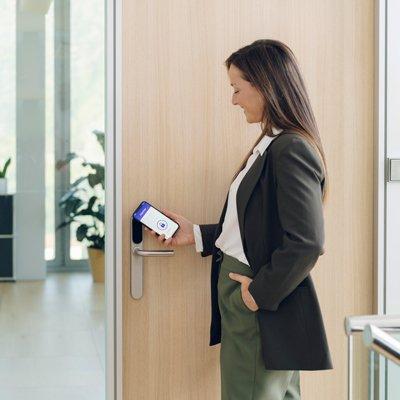 |
| Trucks are controlled and zoned into Press Shop, Body Shop, Trim and Final, Parts and Logistics, and Linde workshop |
Eight electronic key and intelligent access management systems were recently introduced to control over 200 fork trucks and other materials handling equipment used for the Just-In-Time transportation of product materials and components to the production line. We ask why – what was the rationale? And we question the benefits Jaguar Land Rover expect to get from this control of fork truck usage.
Manufacturer of the world-renowned Land Rover Freelander 2, the company has one of its three manufacturing sites at Halewood, Liverpool.
Traka was first investigated for key management control to restrict driver access to fork trucks some three to four years ago on the grounds of ‘accountability’ from a safety perspective. After some consideration, the project was shelved. However, ground swell was strong and, following representation from the on-site Linde fork truck Engineering Manager, it was decided to revisit the idea, this time on a major cost-saving justification.
Previously owned by Ford and now part of the Tata Group, Jaguar Land Rover is self-financing and is acutely aware of costs. On a site of several square kilometres, Jaguar Land Rover employs more than 1,900 people and produces a car every 135 seconds, taking 2.5 days in production from start to finish. The site is vast, taking more than 25 minutes to walk across the factory.
All achieved by using Traka to manage the keys; restricting access only to authorised drivers in each of the specific areas. With a range of trucks from Reach and Counter Balance to Tow Trucks and Die Handlers, historically these would be used at remote locations across the plant. Trucks are now controlled and zoned into five areas; Press Shop, Body Shop, Trim and Final, Parts and Logistics, and Linde workshop.
Traka systems were first installed in July 2008 during the summer shut down and have now been fully implemented on a phased roll-out basis.
The less critical areas were tackled first as Jaguar Land Rover wanted to learn as much about the system and the information available from the reports as possible, thus getting maximum benefit from the next installation phase. Currently, there are eight systems installed for managing over 200 new Linde fork trucks and other keys on site. Traka systems are configured as iFob per person and for fixed return.
Godfrey Anderson (Traka MHE Sales Manager) explains what this means, “Firstly, iFob (intelligent key fob) is the term used to describe the small metal bullet shaped Fob (containing an electronic data chip) that is usually attached to a key with a security seal, and then locked into a designated port on the receptor strip within the Traka key cabinet.
Each iFob will only be released if the person identifying him/herself to the system firstly has permission to access the cabinet and, secondly, only then to the iFobs (or keys) for which they are authorised. This is all controlled through the supporting Traka32 software, with the user and key details stored on a centrally located SQL database, accessed remotely via any one of a number of strategically located desktop PCs. Fixed Return simply means that when an iFob (hence key) is taken, it must be returned to the same port in the cabinet later.” Whilst a random return option is available (which allows any iFob to be returned to any port within any cabinet on the system) Jaguar Land Rover has opted for fixed return as it enables supervisors to see exactly which keys are out of the system and who has them, from a simple visual check of the cabinet.
One step further
However, Traka takes this all a stage further explains Godfrey, “Because the iFob has inbuilt electronic intelligence, we can use this device to actually become the key itself – an intelligent electronic key. Each truck is fitted with a ‘receptor socket’ into which the iFob can be inserted by the driver – and only when inserted will the driver be able to start the truck. The iFob replaces the conventional key and overcomes the common problem of all trucks being keyed alike, which makes it almost impossible to know who has driven any particular truck in the case of an accident or incident that breaches Health & Safety regulations."
Intelligent electronic key
With the iFob now acting as an intelligent key, it can be used in one of two ways; iFob per vehicle or iFob per person. Jaguar Land Rover has opted for iFob per person, which means that a driver need only take one iFob from the system and can, based upon his/her user profile, use this single iFob to start all trucks for which he/she has authorisation, based upon competency testing and a valid licence – all of which is recorded in the Traka32 software. The user simply needs to identify him/herself to the cabinet.
 |
| The inclusion of the shock sensor has radically changed the way in which drivers treat the trucks |
At Jaguar Land Rover, this is achieved using the company ID card. The Traka system will then automatically write the user access permissions to the iFob (known for each unique driver) – and that one iFob will enable the driver to move from truck to truck (for which he/she is authorised to drive). For Jaguar Land Rover, the big time saving advantage is simple - the driver does not need to return to the cabinet to ‘pick-up’ another key to use another truck.
Another benefit - there is no longer a single key for each truck… so if a driver goes home with an iFob in his/her pocket, the truck can still be used by any other authorised driver with their iFob. Of course, should an iFob not be returned, a quick visual check at shift end will identify any that are missing, and the supervisor can do an on-screen check or run a quick report to determine the name of the key holder.
Pre-operational checks – easily managed
In conjunction with the Data Logger, the truck is also fitted with an acceptance button as standard and the Immobilisor Shock Sensor as an option. The inclusion of the acceptance button ensures that the pre-operational safety check must be completed, acknowledged and recorded electronically for every truck, on an individual driver by driver basis and replaces the conventional paper based record used prior to the implementation of the Traka system.
Unlike more costly competitive products which rely on RFID technology for data transmission, this information is automatically downloaded when the iFob is returned to the cabinet by the driver. Stored in a central database, it is available to managers along with other user activity reports to identify who has used which vehicle and when, and if there was any damage or fault reported on the truck.
Ensuring faults or damage is acted upon quickly saves time and money
Any reported fault or damage is quickly acted upon and, in this case, a phone call to the Linde workshop results in an engineer bringing a replacement truck to the work area – saving in production time. The Traka system also has the ability to automatically generate an email – so every fault report is recorded and it is easy to keep a check if service level agreements are being adhered to.
Shocks sensors – reduce truck collisions
The inclusion of the shock sensor has radically changed the way in which drivers treat the trucks (and the stock being transported). Each sensor is calibrated against G-Force impact, and can be pre-set to cut-out the truck following an impact above the determined threshold. At Jaguar Land Rover, the cut-out operates 10 seconds after impact giving the driver enough time to back away from danger such as collapsed racking, but not enough to drive away from an accident scene. All this information is recorded in the driver’s iFob, and is downloaded when next returned to the
Traka cabinet. A truck, once cut-out can only be restarted by a supervisor or service engineer with a special service iFob. For any cut-out incident or accident, a driver must complete a report form. Daily downloads from Traka enable a report to detail all incidents, and these can then be reconciled against the driver incident report. Failure by a driver to report and complete an incident report is now deemed a serious offence and is subject to disciplinary action.
The main areas that Jaguar Land Rover needed to address in terms of fork truck control were:-
- Accountability of drivers
- Damage Control
- Cost Savings
- H&S compliance.
All of these have successfully been achieved by implementing the Traka systems. But by far the most striking change has been that of modified driver behaviour; to give an example…
“Trucks were fitted with the sensor but we didn’t implement the cut-out initially so we could monitor the situation. Typically there were over 27 incidents a week. However, after informing the drivers and initiating the cut-out facility, within a matter of weeks there was just one.” States Godfrey.
“Because the iFob has inbuilt electronic intelligence, we can use this device to actually become the key itself – an intelligent electronic key" |
Previously, when keys were missing and others were left in trucks, there was no accountability. Anybody could jump on and drive, and even if there was no key present, a driver would almost certainly have one that worked in most trucks. With no accountability there was no restriction, trucks were taken and used elsewhere. They were often treated badly with resulting damage as no one could trace those who had used them. There was often damage to stock, pallets and racking as well as to the trucks themselves.
The benefits - they add-up
By reducing truck damage, downtime is eliminated and trucks spend less time in service for repair. With the new level of accountability, there is also substantially less infrastructure damage, resulting in lower operating costs.
Asked how the drivers reacted when Traka was first introduced, the general consensus is that those drivers who were good drivers took to the system well – others quickly realised they would have to modify their behaviour or risk facing disciplinary action. Drivers saw a positive side – firstly it has done away with paper based forms for acceptance testing – it is now all electronic – better for the drivers and better for the company to manage records with less administration effort. Drivers also know that the trucks will be
‘in-place’ when needed and they will be in good working condition. For any unreported damage that does appear, it is possible to quickly trace the previous driver. Each driver knows that he/she is responsible, can be traced and any damage or faults need to be reported immediately. It has certainly improved productivity substantially, as well as reducing damage to stock, trucks and infrastructure considerably.
Traka does exactly what it is intended to do - it ensures controllability and accountability. Asked why Traka was selected, Godfrey Anderson explains, “ during the sales cycle we took the Jaguar Land Rover European Operations Manager to see two identical trucks placed side by side, one of which had been brought in to provide temporary cover. One was six months old (without Traka) the other, on loan, was six years old and had been controlled by a Traka system at its previous site. This key decision maker was asked to guess which was the older. Needless to say, despite its age, the truck controlled by Traka was less battered and had less damage.”
A spin-off from having Traka to manage fork truck control at Jaguar Land Rover is that it has been adopted elsewhere in the plant – specifically to manage keys to buildings and rooms, thus restricting and controlling who has access. Previously, keys to store areas were simply hanging up in an office.
















